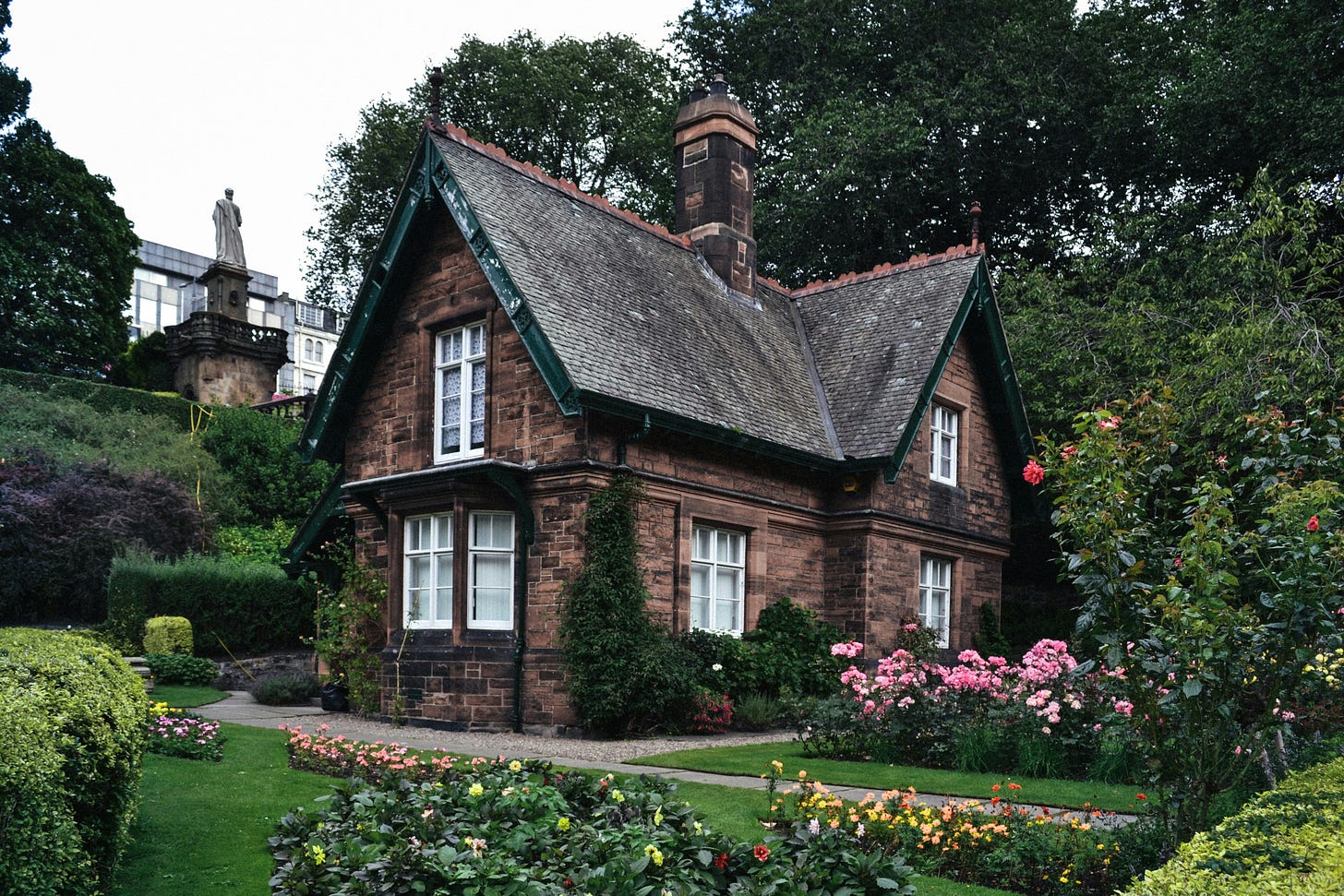My Therapist Says I Can’t Be a Cottage Hag
Small doses of solitude can help us regulate. But long stretches of aloneness can leave us stuck.
Lately, with the utter chaos that is the world right now, I find myself fantasizing about retreat.
I picture a little cottage tucked away in the woods, a sprawling herb garden out back, a couple of dogs keeping watch from the windowsill (I know cats are more associated with cottage hags, but alas, this hag is allergic).
In this dream, I go into town once a month for supplies, maybe trade jars of dried chamomile for fresh fruit, and then slip back into the quiet. Cottage-hag style.
It feels so tempting—to step out of the noise, the headlines, the grind, and just tend to myself and the land. Wouldn’t that be easier than trying to live in this constant swirl of hypervigilance?
So I told my therapist about my plan. She listened, smiled, and then said flatly: “You can’t be a cottage hag. That’s not a good idea for you. You need to rely on your community.”
Ouch.
I wanted her to say, “Yes! Go, live your best cottage hag life.” Instead, she pointed me back toward something I didn’t really want to hear:
Resilience isn’t built in isolation.
And here’s where I pause to give credit where it’s due: the term cottage hag itself belongs to Dr. Stephanie Lanham, who coined it (and graciously gave me permission to use it). She captured, with two words, that longing so many of us feel for retreat and a simpler life.
The Cottage Fantasy and Your Nervous System
I’ll admit I sulked a little after that therapy session. My therapist’s reminder rubbed against the grain of what I wanted: permission to hide. But the more I thought about it, the more I recognized the truth in her words.
Small doses of solitude can help us regulate. But long stretches of aloneness, especially when prompted by overwhelm, can leave us stuck in nervous system states that are less about safety and more about protection.
My cozy cottage image, if lived full-time, might actually be a slide into disconnectedness.
Which brings me to this season of food holidays. These meals are never just about food. They’re about nervous systems, too. Polyvagal theory teaches that our nervous systems move between states of protection and safety. In ventral vagal states, we feel grounded, curious, connected. And one of the surest routes into ventral energy is community.
Think about the feeling of eating with people you trust. Shoulders drop. Breath slows. Conversation sparks laughter. Even the simplest food communicates: you belong here, you are safe.
Food in Community
This is a message many of us are starved for. Western culture praises hyper-independence. We’re told to pull ourselves up, not to be a burden, to prove we can do it all alone.
But biology tells another story.
We are wired for co-regulation. Our bodies are designed to calm and orient when we sense safety in each other’s eyes, voices, gestures. And food is one of the most ancient rituals of that wiring.
From a food perspective, it might look like:
Cooking together: Let a neighbor chop while you stir. The meal becomes connection, not just sustenance.
Meal trains: When someone faces illness, loss, or new parenthood, organize dinners. Feeding each other says: you are held.
Workplace lunches: Step away from your desk. Break bread in the break room. Tiny acts of co-eating soften the edges of stress.
Neighborhood swaps: Exchange jars of soup, loaves of bread, garden greens. Food becomes a bridge.
Ritual meals: Mark birthdays, job changes, or seasons with a meal. These rituals remind us that life is shared.
Even digital gestures count. Sending a picture of your dinner to a friend or swapping recipes in a group text can echo ventral connection.
I Have to Admit—My Therapist Was Right
This is why my therapist was right. The myth of self-sufficiency isn’t just exhausting—it’s dysregulating. When we normalize being alone every night, powering through without help, or treating food as fuel only, we strip away the relational safety cues our bodies crave. No wonder so many of us dream of escape into the woods.
But the alternative isn’t to abandon solitude entirely. It’s to balance it. To hold space for the cottage hag part of us—grow the herbs, light the candles, savor the soup—and then to carry that nourishment back into community.
So no, I won’t be disappearing into the woods full-time. But I can take pieces of that idealized image and bring them into my life - a pot of soup on the stove to share with my family, a cup of tea with the dog cuddled close.
Food isn’t just calories or nutrients. It’s a lifeline of belonging. A way of saying: I see you, I’m with you, we’re in this together.
And maybe that’s the truest cottage hag wisdom of all: to tend not just our own gardens, but also the communal tables where we all can eat, rest, and grow.



I feel this so much! I so often resort to hanging out on my couch with my dog when the world is too loud, but I know not having connections is not helping me in the long run.
I’ve had such a hard time finding friends as an adult though. No one seems to want to commit to anything and I feel like I’m always the person carrying the weight of a friendship.